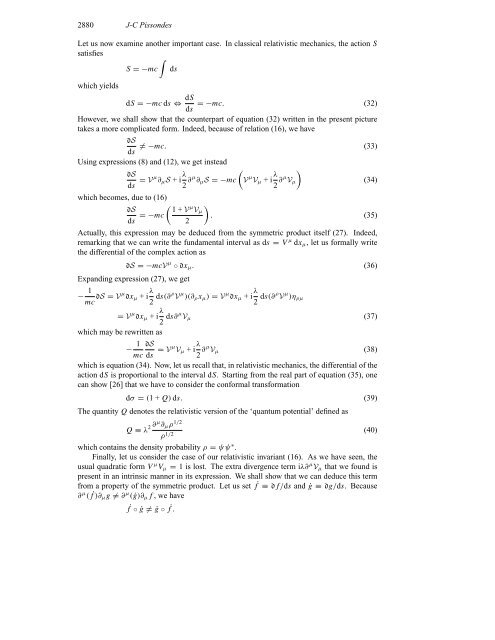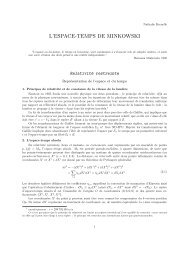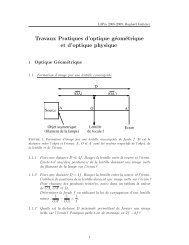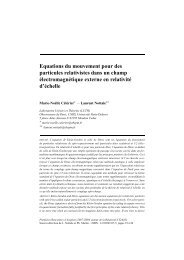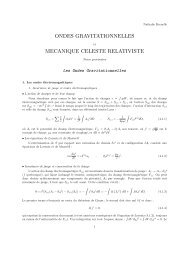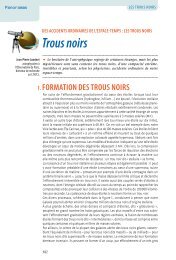J. Phys. A: Math. Gen. 32 (1999) - LUTH - Observatoire de Paris
J. Phys. A: Math. Gen. 32 (1999) - LUTH - Observatoire de Paris
J. Phys. A: Math. Gen. 32 (1999) - LUTH - Observatoire de Paris
Create successful ePaper yourself
Turn your PDF publications into a flip-book with our unique Google optimized e-Paper software.
2880 J-C Pisson<strong>de</strong>s<br />
Let us now examine another important case. In classical relativistic mechanics, the action S<br />
satisfies<br />
<br />
S =−mc ds<br />
which yields<br />
dS =−mc ds ⇔ dS<br />
=−mc. (<strong>32</strong>)<br />
ds<br />
However, we shall show that the counterpart of equation (<strong>32</strong>) written in the present picture<br />
takes a more complicated form. In<strong>de</strong>ed, because of relation (16), we have<br />
dS<br />
= −mc. (33)<br />
ds<br />
Using expressions (8) and (12), we get instead<br />
dS<br />
ds = Vµ ∂µS +i λ<br />
2 ∂µ <br />
∂µS =−mc V µ Vµ +i λ<br />
2 ∂µ <br />
Vµ<br />
(34)<br />
which becomes, due to (16)<br />
dS<br />
ds =−mc<br />
µ <br />
1+V Vµ<br />
. (35)<br />
2<br />
Actually, this expression may be <strong>de</strong>duced from the symmetric product itself (27). In<strong>de</strong>ed,<br />
remarking that we can write the fundamental interval as ds = V µ dxµ, let us formally write<br />
the differential of the complex action as<br />
dS =−mcV µ ◦ dxµ. (36)<br />
Expanding expression (27), we get<br />
− 1<br />
mc dS = Vµ dxµ +i λ<br />
2 ds(∂ρV µ )(∂ρxµ) = V µ dxµ +i λ<br />
2 ds(∂ρV µ )ηρµ<br />
= V µ dxµ +i λ<br />
2 ds∂µ Vµ<br />
(37)<br />
which may be rewritten as<br />
− 1 dS<br />
mc ds = Vµ Vµ +i λ<br />
2 ∂µ Vµ<br />
(38)<br />
which is equation (34). Now, let us recall that, in relativistic mechanics, the differential of the<br />
action dS is proportional to the interval dS. Starting from the real part of equation (35), one<br />
can show [26] that we have to consi<strong>de</strong>r the conformal transformation<br />
dσ = (1+Q) ds. (39)<br />
The quantity Q <strong>de</strong>notes the relativistic version of the ‘quantum potential’ <strong>de</strong>fined as<br />
Q ≡ λ 2 ∂µ ∂µρ1/2 ρ1/2 (40)<br />
which contains the <strong>de</strong>nsity probability ρ = ψψ∗ .<br />
Finally, let us consi<strong>de</strong>r the case of our relativistic invariant (16). As we have seen, the<br />
usual quadratic form V µ Vµ = 1 is lost. The extra divergence term iλ∂ µ Vµ that we found is<br />
present in an intrinsic manner in its expression. We shall show that we can <strong>de</strong>duce this term<br />
from a property of the symmetric product. Let us set f˙ ≡ df/ds and ˙g ≡ dg/ds. Because<br />
∂ µ ( f)∂µg ˙ = ∂ µ ( ˙g)∂µf ,wehave<br />
f˙◦˙g= ˙g ◦ f.<br />
˙


